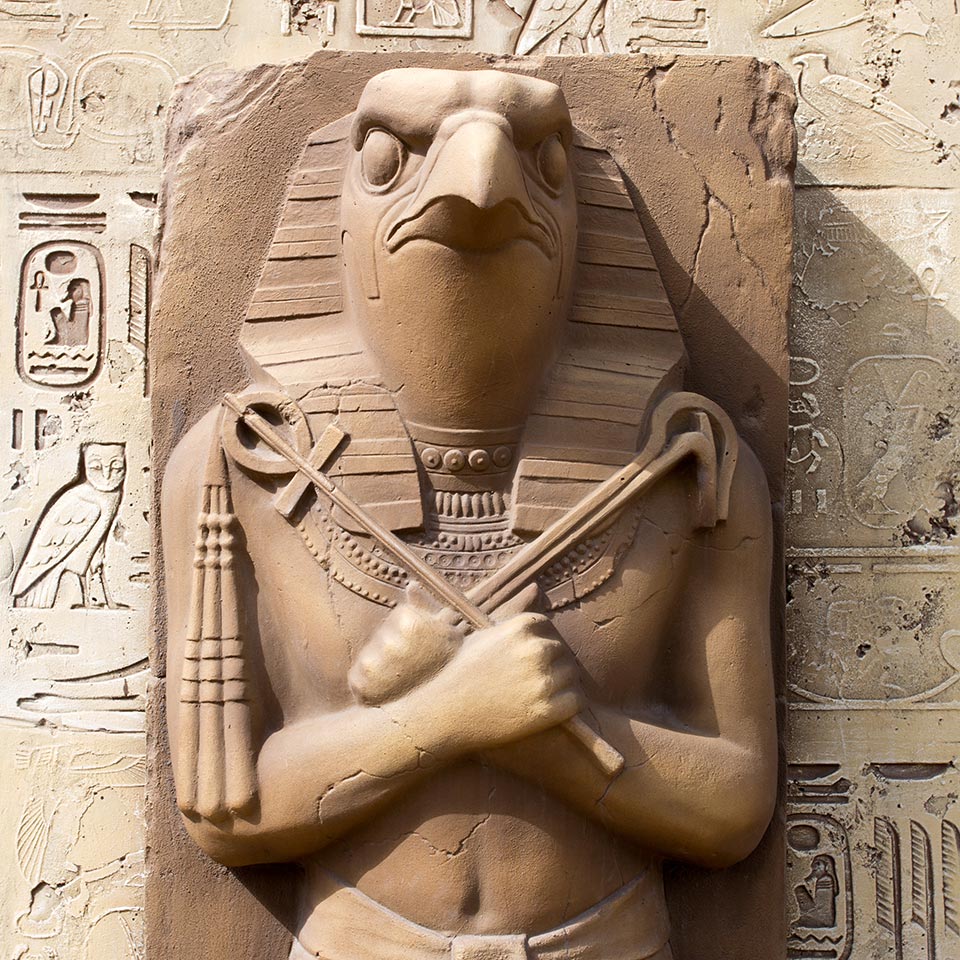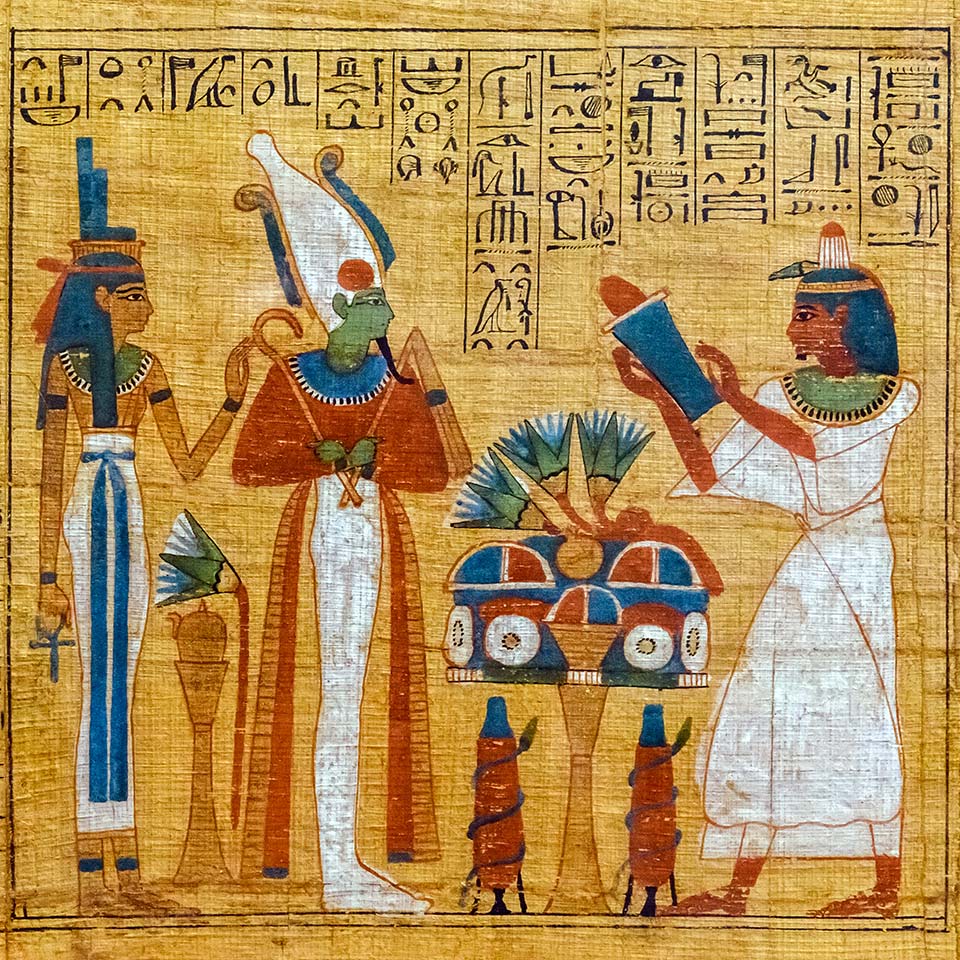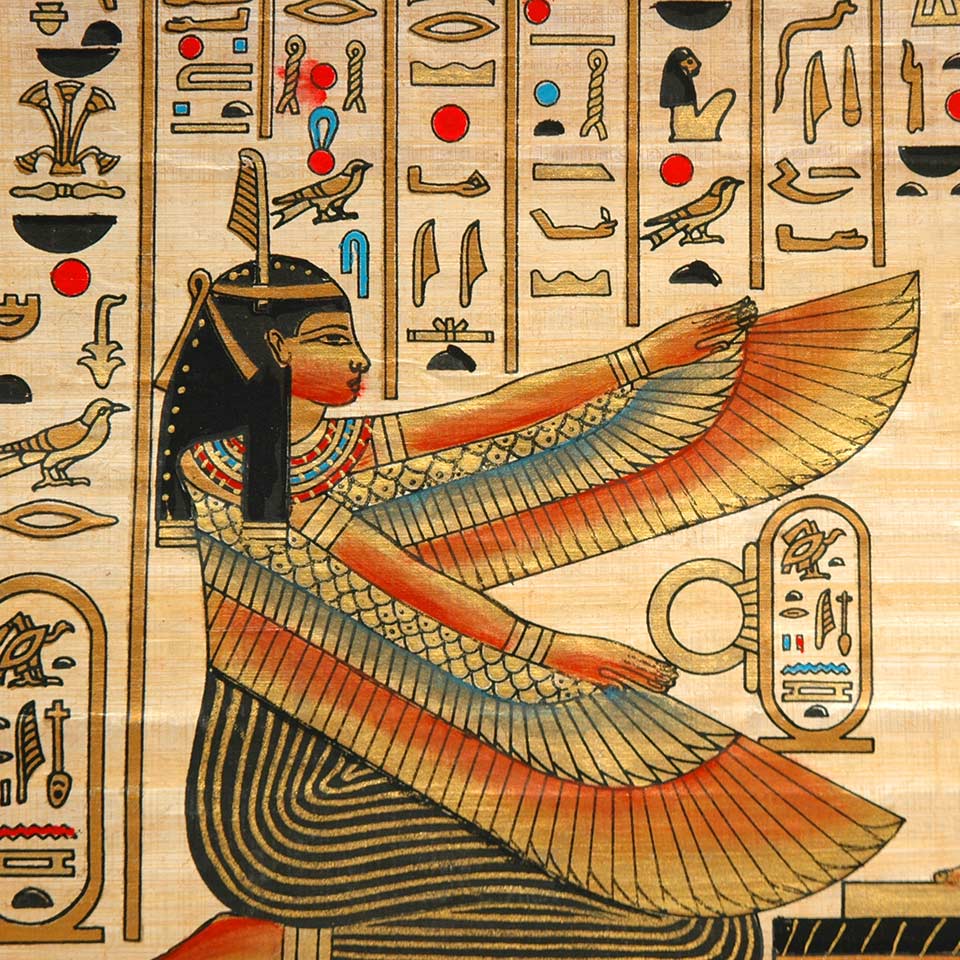Ancient Egyptian religion was a complex and intricate system that played a central role in this fascinating culture for thousands of years. Our understanding of ancient Egyptian religion is based on archaeological evidence, temple inscriptions, tomb paintings, and ancient texts (including Pyramid Texts, Coffin Texts, and Book of the Dead). Interpretations are therefore subjective, and some aspects of the religion are still subject to ongoing research and debate. Nevertheless, there are many widely-accepted facets of ancient Egyptian religion to explore…

Polytheism
Ancient Egyptians believed in a vast pantheon of gods and goddesses. Each deity had its own unique characteristics, powers, and responsibilities, and represented various natural and abstract elements (e.g. the sun, fertility, wisdom, war, etc). Some of the most important deities included:
- Ra (Re): one of the most significant deities in ancient Egypt. He was believed to rule over the sun and represented its life-giving and creative power. Ra was often depicted as a falcon-headed figure with a sun disk on his head, and was believed to sail through the sky on a solar boat and pass through the underworld each night. Whilst there, he would defeat a fearsome snake god named Apopis to rise again the morning after.
- Osiris: originally a vegetarian god with links to crops, and later revered as the first king of Egypt and the god of the afterlife, resurrection, and fertility. He played a central role in each soul’s journey to the afterlife, and was often depicted as a mummified figure with green skin, or as a pharaoh with a distinctive headdress who held crook and flail symbols. Osiris was also linked to the cycle of the river Nile’s flooding that was so integral to Ancient Egyptian society.
- Isis: the goddess of magic, fertility, and motherhood. She was considered to be the ideal wife and mother, and was instrumental in the resurrection of her husband, Osiris, after he was murdered (and dismembered) by his brother, Seth. Isis was often depicted as a woman who wore a headdress shaped like a throne. Interestingly, Isis is absent from the earliest Egyptian records, although - over time - she became the preeminent goddess, and was still being worshipped in the Greco-Roman period.
- Horus: the god of the sky, war, and protection. He was strongly associated with the sitting pharaoh, and was believed to be the son of Osiris and Isis. Horus was conceived after his father’s murder, and some traditions hold that he lost his left eye whilst fighting his avenging battle against Seth. He was typically depicted as a falcon or as a human with a falcon's head, wearing a double crown.
- Amun: the king of the gods, associated with air, wind, and fertility. He rose to prominence during the New Kingdom, where he was given credit for the overthrow of the foreign Hyksos dynasty by the native rulers of Thebes. He was often merged with Ra, becoming Amun-Ra, the supreme solar deity. Amun’s name meant “hidden one, mysterious of form”, and he was often shown wearing a tall plumed crown.
- Hathor: the goddess of love, beauty, music, and joy. The consort of Horus, she was often depicted as a woman with cow horns (or ears), which symbolised her nurturing and maternal qualities. Hathor was also associated with the afterlife and was considered to be a protective deity. Because tombs were usually built on the west bank of the Nile, she was often called “the lady of the west”.
- Anubis: the god of mummification, the afterlife, and the protector of the deceased. He was famously represented as a jackal, or as a man with a jackal's head. Anubis guided each deceased to the hall of judgement, and played a vital role in the weighing of the heart ceremony. Before Osiris rose to prominence as the lord of the underworld, Anubis was the most important god of the dead, and was responsible for Osiris’ own embalming.
- Thoth: the god of wisdom, writing, and knowledge. The oldest of the gods (often serving as an intermediary between them), he was often portrayed as a man with the head of an ibis or as a baboon. Thoth was associated with writing, magic, and was believed to have invented hieroglyphs and the written language. In some reliefs, Thoth was portrayed as the god who weighed the hearts of the dead, and delivered a judgement to Osiris. If a person was not found to be worthy by Thoth, then their heart was eaten by Ammit, the Devourer, and they were obliterated from the universe.
- Sekhmet: the lioness-headed goddess of war, destruction, and healing. She was the daughter of Ra, and had both protective and destructive powers, being associated with the sun and fire. Sekhmet was called upon to protect the pharaoh and to ward off evil forces, although sometimes she was believed to cause plagues, in addition to bringing deliverance.
- Ptah: the creator god and patron of craftsmen and architects, Ptah headed a triad of gods who were worshipped at Memphis (including Sekhmet and Nefertem). He was associated with craftsmanship, creation, and fertility. Ptah was usually illustrated as a mummified figure wearing a skullcap, or as a man with a beard and holding a sceptre.

The Pharaoh
The pharaoh, as the ruler of Egypt, held a special status as the intermediary between the gods and the people. Pharaohs were believed to be divine in of themselves and were closely connected to the gods. They possessed the divine right of kings, and their actions and rituals were crucial for maintaining cosmic order. The official crown of the Pharaoh was formed from the unification of Upper Egypt’s Red Crown and Lower Egypt’s White Crown, although numerous ceremonial headdresses developed over time according to the preferences of the different dynasties.
Ma'at
Ma'at was a fundamental concept of ancient Egyptian religion, representing the principles of truth, justice, harmony, and balance. Upholding ma'at was necessary to ensure the prosperity and stability of the universe. Ma’at was also the name of the goddess who personified the principles of truth, balance and cosmic justice.
Rituals
Egyptians worshipped their gods using various rituals that were performed in temples and shrines. These rituals included offerings, prayers, and ceremonies that were conducted by priests, priestesses and shamans. Festivals and processions were also important religious events to observe.
Afterlife
The belief in the afterlife was central to ancient Egyptian religion. Egyptians believed in a complex journey after death, involving judgement, preservation of the body through mummification, and an ultimate reward (or punishment) in the afterlife. Tombs - such as pyramids and rock-cut tombs - were built to safeguard the deceased and their belongings. The Ancient Egyptians believed that even though the spiritual part of a person could roam freely after death, they still required a physical “body” (sometimes, this could be in the form of a substitute statue) to settle into a permanent home.
Burial
Proper burial and funerary practices were crucial for ensuring a successful transition to the afterlife. The deceased's body had to be preserved using mummification (although Old Kingdom Egyptian bodies tended to be naturally preserved in desert pits via desiccation), and funerary texts (such as the Book of the Dead) were placed in the tomb to guide the deceased’s soul through the perilous journey. By the Fourth Dynasty, canopic jars had begun to be used to safeguard certain important parts of the deceased (i.e. their organs). Even once the ancient Egyptians had mastered the craft, it could take up to 70 days to achieve mummification! Living relatives often continued to tend the graves of their deceased family members, bringing food to them or reciting prayers on their behalf.
Cults & Local Deities
Alongside the major gods that were worshipped throughout Egypt, there were also regional and local deities associated with specific cities or areas. These local cults had their own rituals, temples, and festivals, and often maintained their own unique mythology. Usually, the cult statue stood at the centre of a temple shrine, and only temple officials were allowed to access the god’s “domain”. Normal citizens of ancient Egypt tended to worship using home shrines.
Symbolism
Ancient Egyptian religion was rich in symbolism and iconography. Each god had specific symbols and representations - such as animal forms, sacred objects, or hieroglyphic signs - which carried deep religious and symbolic meanings.

Magic
Magic in ancient Egyptian culture was deeply intertwined with religion, and was often performed by priests or individuals with secret knowledge. It was believed that the gods themselves possessed magical abilities and, by invoking them through spells and rituals, humans could access and harness that power. Magic was considered to be a legitimate and practical means of interacting with the divine, and influencing the world. The use of spells, amulets, and rituals aimed to protect individuals from evil forces, illness, and misfortune. Magic was also employed in the context of healing practices.
- Protective magic: often used to safeguard against various threats and dangers. Egyptians believed in the existence of malevolent spirits, demons, and evil forces that could cause harm to individuals. Magic spells and rituals were employed to ward off these negative influences and ensure personal safety.
- Healing and medical practices: magic played a crucial role in ancient Egyptian medical practices. Physicians and healers combined medical knowledge with magical spells and rituals to treat illnesses and injuries. They believed that invoking specific deities or using magical incantations could aid in the healing process.
- Amulets and talismans: amulets were believed to hold protective powers and were worn or carried by individuals to ward off evil and bring good fortune. Amulets took various forms, including scarab beetles, the Eye of Horus, ankh symbols, and more. Each amulet had its specific purpose and significance, and was often tied to particular deities or concepts.
- Ritual magic in religious ceremonies: magic was an integral part of religious ceremonies and rituals. Priests and priestesses performed magical rites to invoke the gods, seek their favour, and ensure the success of the rituals. Practices included purification rites, the recitation of spells, and the use of ritual objects and symbols.
- Funerary magic: magic played a vital role in ensuring a successful journey to the afterlife. Spells and incantations were inscribed on funerary objects and the walls of tombs to guide and protect the deceased. The Book of the Dead (a collection of magical spells and instructions) was often placed in tombs to help the deceased to navigate the challenges of the afterlife.
- Divination and oracles: Egyptians used magical techniques to seek guidance and insight into the future. Divination methods included interpreting dreams, reading omens, and consulting oracles. These practices aimed to foresee potential events, make informed decisions, and seek the blessings of the gods.
- Symbolic and ritualistic magic: symbolism played a significant role in Egyptian magic. Certain symbols and gestures were believed to possess inherent magical power. For example, the act of drawing and painting magical images or inscriptions was seen as a way to manifest and control magical forces.
Legacy
The ancient Egyptian religion persisted for over three millennia, adapting and evolving over the course of this time. It influenced art, architecture, and societal structures, leaving a lasting impact on Egyptian culture and spirituality. And, of course, ancient Egypt continues to captivate the minds of millions of people around the world even today, in ways and forms that its residents could never have imagined.
If you’re fascinated by ancient Egypt, then we have a full range of diploma courses on offer, including Egyptology, Ancient Egyptian Magic, Egyptian Hieroglyphs and Ancient Egyptian Shamanism. Each of these courses is available for £29 (save £98 on each!), and offers a glimpse into the world of this fascinating historical kingdom.




